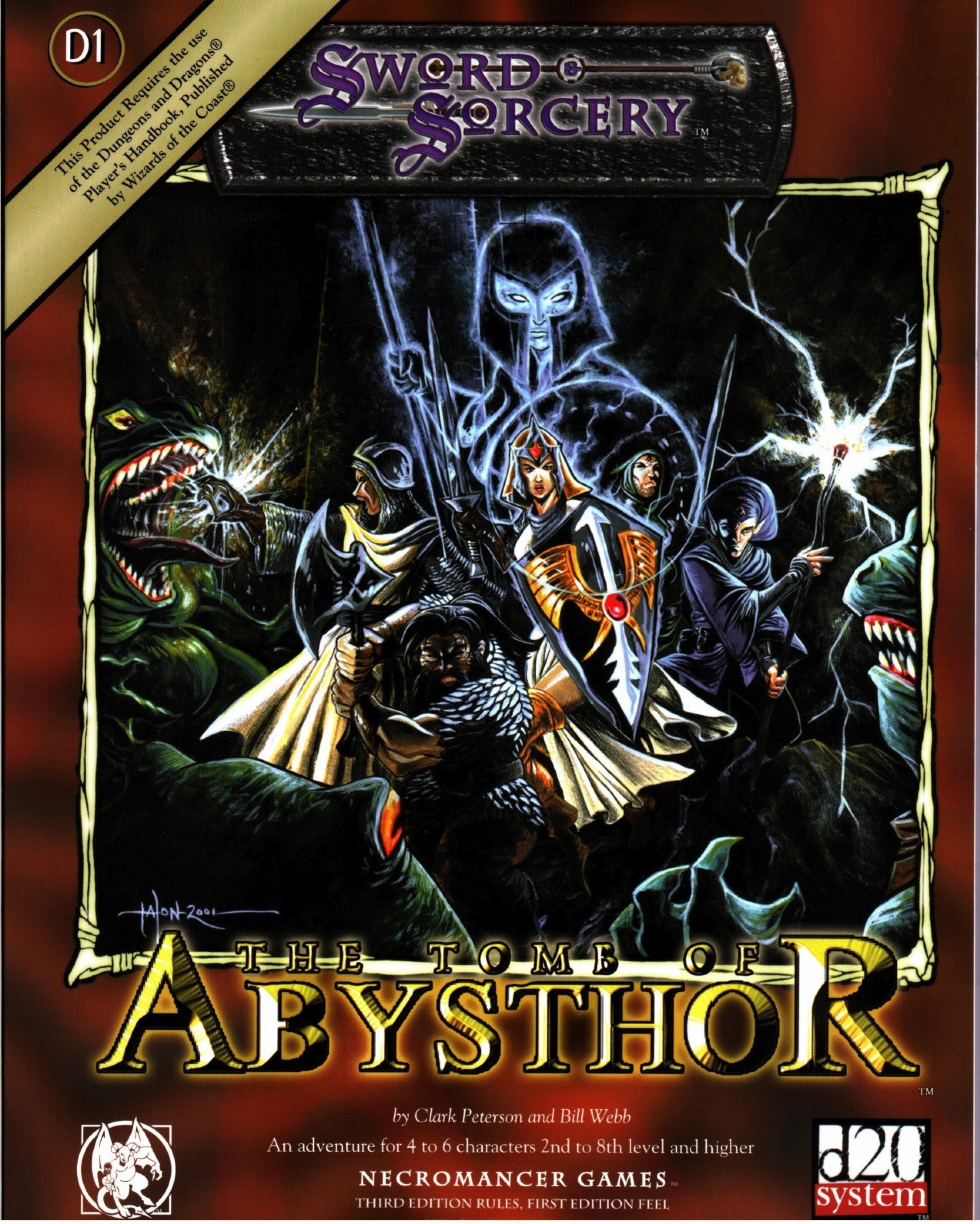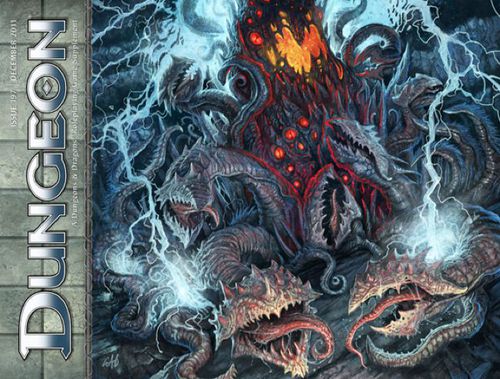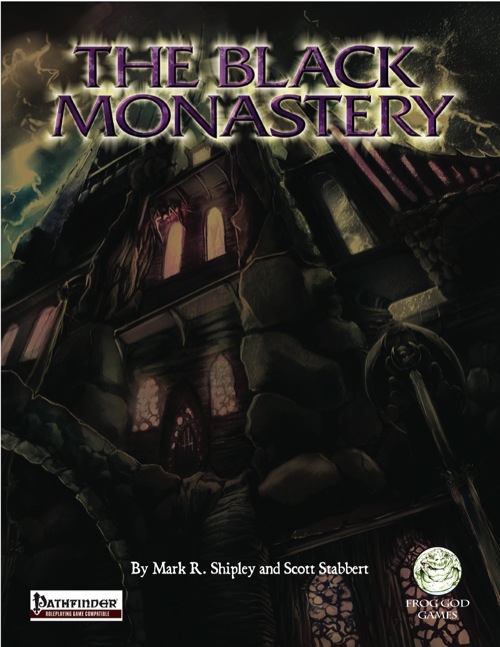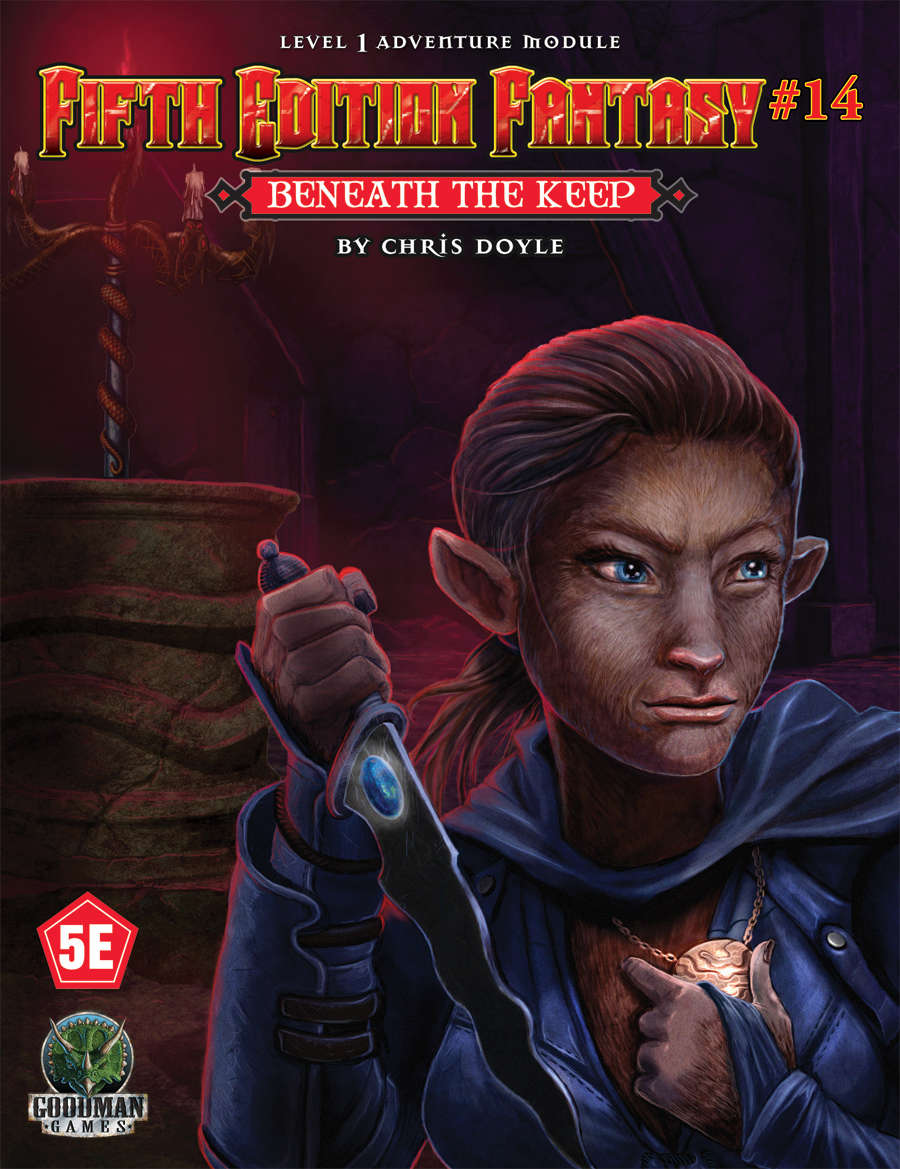
The Creche of Set is a companion adventure made to go along with the events unfolding in Folio #10 (DF3 Forgotten Temple of Tefnut). It contains the information needed to run a side advenute during the events of The Hidden Valoria Campaign. After finding the secret under-passage in the fallen Temple of Tefnut, the party can descend through a stair located between two rooms. Down in the dark they will encounter a fallen tribe of Lizardmen who are now influenced by the mummy Aman-Utep in the halls above. Destroying this tribe, and recovering an artifact they possess, could prove highly valuable to the completion of the Lost Temple adventure. This adventure is formatted to both 1E & 5E gaming rules.

Beneath the roots of a silver elm, there lies a sidereal prison… Vaz’kin’rai is a one-session adventure for the 5th Edition of the world’s most popular roleplaying game, which sees 1st level heroes venture beneath the village of Dur to uncover the secrets of a mysterious cosmic vault. What will the heroes find within? And what price might they pay for uncovering it? Featuring: Two bespoke creature statblocks, including a Paragon Creature! Four new magic items! Five premade characters suitable for playing through Vaz’kin’rai! A host of original artwork by Izzy Collins, Emma Durno, and Robin Baxter! A fully supported hook, as well as suggestions for others and how to develop the storylines and themes the adventure introduces into a larger game! A selection of free companion Sonoria – audio ambiences and sound effects you can use to bring the adventure to life sonically! Vaz’kin’rai comes embedded in an original campaign setting, but is self-contained enough that it can be sited easily in most other campaign settings with minimal effort. A selection of deities and lineage origins are also provided in the appendices to help fit characters within Vaz’kin’rai’s setting as presented. Go forth, and see what lurks within the vault of Vaz’kin’rai… Published by Animancer

Visit Marlinko, a borderlands city where life takes a strange fever-dream cast, in this 72-page urban adventure fantasy supplement. Part city-setting, part full-blown adventure, Fever-Dreaming Marlinko is a stand-alone companion to the Slavic acid fantasy weirdness of the Slumbering Ursine Dunes. Contains background and hooks for the city's four city quarters, two complete dungeon adventure sites, two new players classes (Mountebank and Robodwarf), Chaos Index with escalating events/triggers scattered throughout the city, news generator with full news briefs and hooks, and tiger-wrestling mini-game.

Utopian Tower is a solo adventure which brings a new PC/player to the small Halfling village of Phebus on their way to a job opportunity. While the PC has time to spare they learn of a haunted tower that has the villagers on edge and is asked to investigate for a reward! While in town the PC meets a bard also headed to a job opportunity leading to a potential fellowship…if they survive! An excellent setting to teach a player new to the game on the basic mechanics. The adventure ties in roleplaying in a town environment, overland and dungeon movement, as well as combat encounters!

Jungle, tomb rading style adventure that sets the group to a new locale, with it's own eco systems and cultures. Exploration adventure, with glint of gold as a catalyst. The adventurers accidently find a map, which leads them to this unknown land. "Can you unravel the map's mysteries and find your way to the promised treasure? Or will your dreams end only in death and an unmarked grave far from home! Only the bravest characters of levels 3-5 will live to discover that all that glitters is not gold, but much, much more!" TSR 9126

A fast-paced one-shot from the bestselling author of The Secrets of Skyhorn Lighthouse! A shadowy force gathers inside the abandoned halls of Lastwatch Keep. Can the players defeat the drow invaders before they escape to the underworld with sinister intelligence about the surface? Shadows of Lastwatch Keep is a one-shot adventure for four or five 4th-level characters. It takes about 3-4 hours to complete and includes: -A drow strike team desperate to escape the keep’s surprise foe -A new monster, the drow commando -Combat cards for each monster, PC, and special treasure -A beautiful, hand-drawn map by Jake from Beware the Wizard

With your first set of adventures firmly under your belt you are relaxing and basking in the glory of a job well done. While at the local tavern imbibing in some well-earned spirits, a commotion can be heard outside. As you step outside the villagers are pampering two children who apparently just rode into town on a very sweaty and tired pony. An arrow is sticking out of the mount’s flank. As the animal is removed the townspeople pepper the children with questions as both are obviously afraid. It would appear the drinks will have to wait.

Restore an Abandoned Temple Enter the catacombs near the desecrated Temple of Muir, Goddess of Paladins, and search for the lost tomb of Abysthor. Will your party be able to cleanse the evil that now inhabits these once-sacred halls, and recover the Stone of Tircople? Can your characters survive the traps of an undead sorcerer? Will your players discover the chamber of Living Rock and the secret power it holds? Adventure awaits! Gold and Glory! A fantasy adventure published for the D20 system, The Tomb of Abysthor is the first module in Necromancer Games Dungeon series and can be played as a stand-alone story or in conjunction with The Crucible of Freya and the forthcoming city supplement Bards Gate. What secrets lie hidden in the tomb of Abysthor?

Faced with an unusual alliance of giants raiding the countryside, the party must venture into the steading of hill giant chief Nosnra and uncover maps to the locations of the other giant strongholds. “Steading of the Hill Giant Chief ” can be run as a stand-alone adventure, or you can play it as the first part of a four-part series that continues with “Warrens of the Stone Giant Thane” (Dungeon 198), “Glacial Rift of the Frost Giant Jarl” (Dungeon 199), and “Hall of the Fire Giant King” (Dungeon 200). The adventure is part of the Against the Giants series originally by Gary Gygax, hence the writing credit.

Taag'thrith, born a gith but transformed into an illithid by ceromorphosis, has been finally found purpose: the assimilation & understanding of all knowledge. Taag'thrith plans to unleash a 10th level spell that will grant him just that-at the cost of all sentient life on the Material Plane. Will the heroes be able to traverse the dangerous corpse of a dead God, find Taag'thrith's aqueous lair the Eternal Spirals, & pit their foes against one another in order to destroy the foul lich once and for all? Or will they fall prey to the threats trapped within the Eternal Spirals & sink beneath the surface forever? They Came from the Deep is the second installment in Pretty Little Liches: a trilogy of adventures centered around three unique liches and their lairs designed for high-level play. These three lairs and the surrounding regions can be run independently as individual adventures or tied together into a mini-campaign that centers on the destruction of the Green Hand, an organization of dangerous liches.

The Legend of the Black Monastery Two centuries have passed since the terrible events associated with the hideous cult known as the Black Brotherhood. Only scholars and story-tellers remember now how the kingdom was nearly laid to waste and the Black Monastery rose to grandeur and fell into haunted ruins. The Brothers first appeared as an order of benevolent priests and humble monks in black robes who followed a creed of kindness to the poor and service to the kingdom. Their rules called for humility and self denial. Other religious orders had no quarrel with their theology or their behavior. Their ranks grew as many commoners and nobles were drawn to the order by its good reputation. The first headquarters for the order was a campsite, located in a forest near the edge of the realm. The Brothers said that their poverty and dedication to service allowed them no resources for more grand accommodations. Members of the Black Brotherhood built chapels in caves or constructed small temples on common land near villages. They said that these rustic shrines allowed them to be near the people they served. Services held by the Brothers at these locations attracted large numbers of common people, who supported the Black Brotherhood with alms. Within 50 years of their first appearance, the Black Brotherhood had a number of larger temples and abbeys around the kingdom. Wealthy patrons endowed them with lands and buildings in order to buy favor and further the work of the Brothers. The lands they gained were slowly expanded as the order’s influence grew. Many merchants willed part of their fortunes to the Black Brotherhood, allowing the order to expand their work even further. The Brothers became bankers, loaning money and becoming partners in trade throughout the kingdom. Within 200 years of their founding, the order was wealthy and influential, with chapters throughout the kingdom and spreading into nearby realms. With their order well-established, the Black Brotherhood received royal permission to build a grand monastery in the hill country north of the kingdom’s center. Their abbot, a cousin of the king, asked for the royal grant of a specific hilltop called the Hill of Mornay. This hill was already crowned by ancient ruins that the monks proposed to clear away. Because it was land not wanted for agriculture, the king was happy to grant the request. He even donated money to build the monastery and encouraged others to contribute. With funds from around the realm, the Brothers completed their new monastery within a decade. It was a grand, sprawling edifice built of black stone and called the Black Monastery. From the very beginning, there were some who said that the Black Brotherhood was not what it seemed. There were always hints of corruption and moral lapses among the Brothers, but no more than any other religious order. There were some who told stories of greed, gluttony and depravity among the monks, but these tales did not weaken the order’s reputation during their early years. All of that changed with the construction of the Black Monastery. Within two decades of the Black Monastery’s completion, locals began to speak of troubling events there. Sometimes, Brothers made strange demands. They began to cheat farmers of their crops. They loaned money at ruinous rates, taking the property of anyone who could not pay. They pressured or even threatened wealthy patrons, extorting money in larger and larger amounts. Everywhere, the Black Brotherhood grew stronger, prouder and more aggressive. And there was more… People began to disappear. The farmers who worked the monastery lands reported that some people who went out at night, or who went off by themselves, did not return. It started with individuals…people without influential families…but soon the terror and loss spread to even to noble households. Some said that the people who disappeared had been taken into the Black Monastery, and the place slowly gained an evil reputation. Tenant farmers began moving away from the region, seeking safety at the loss of their fields. Slowly, even the king began to sense that the night was full of new terrors. Across the kingdom, reports began to come in telling of hauntings and the depredations of monsters. Flocks of dead birds fell from clear skies, onto villages and city streets. Fish died by thousands in their streams. Citizens reported stillborn babies and monstrous births. Crops failed. Fields were full of stunted plants. Crimes of all types grew common as incidents of madness spread everywhere. Word spread that the center of these dark portents was the Black Monastery, where many said the brothers practiced necromancy and human sacrifice. It was feared that the Black Brotherhood no longer worshipped gods of light and had turned to the service of the Dark God. These terrors came to a head when the Black Brotherhood dared to threaten the king himself. Realizing his peril, the king moved to dispossess and disband the Black Brother hood. He ordered their shrines, abbeys and lands seized. He had Brothers arrested for real and imagined crimes. He also ordered investigations into the Black Monastery and the order’s highest ranking members. The Black Brotherhood did not go quietly. Conflict between the order and the crown broke into violence when the Brothers incited their followers to riot across the kingdom. There were disturbances everywhere, including several attempts to assassinate the king by blades and by dark sorcery. It became clear to everyone that the Black Brotherhood was far more than just another religious order. Once knives were drawn, the conflict grew into open war between the crown and the Brothers. The Black Brotherhood had exceeded their grasp. Their followers were crushed in the streets by mounted knights. Brothers were rounded up and arrested. Many of them were executed. Armed supporters of the Black Brotherhood, backed by arcane and divine magic, were defeated and slaughtered. The Brothers were driven back to their final hilltop fortress – the Black Monastery. They were besieged by the king’s army, trapped and waiting for the king’s forces to break in and end the war. The final assault on the Black Monastery ended in victory and disaster. The king’s army took the hilltop, driving the last of the black-robed monks into the monastery itself. The soldiers were met by more than just men. There were monsters and fiends defending the monastery. There was a terrible slaughter on both sides. In many places the dead rose up to fight again. The battle continued from afternoon into night, lit by flames and magical energy. The Black Monastery was never actually taken. The king’s forces drove the last of their foul enemies back inside the monastery gates. Battering rams and war machines were hauled up the hill to crush their way inside. But before the king’s men could take the final stronghold, the Black Brotherhood immolated themselves in magical fire. Green flames roared up from the monastery, engulfing many of the king’s men as well. As survivors watched, the Black Monastery burned away, stones, gates, towers and all. There was a lurid green flare that lit the countryside. There was a scream of torment from a thousand human voices. There was a roar of falling masonry and splitting wood. Smoke and dust obscured the hilltop. The Black Monastery collapsed in upon itself and disappeared. Only ashes drifted down where the great structure had stood. All that was left of the Black Monastery was its foundations and debris-choked dungeons cut into the stones beneath. The war was over. The Black Brotherhood was destroyed. But the Black Monastery was not gone forever. Over nearly two centuries since its destruction, the Black Monastery has returned from time to time to haunt the Hill of Mornay. Impossible as it seems, there have been at least five incidents in which witnesses have reported finding the Hill of Mornay once again crowned with black walls and slate-roofed towers. In every case, the manifestation of this revenant of the Black Monastery has been accompanied by widespread reports of madness, crime and social unrest in the kingdom. Sometimes, the monastery has appeared only for a night. The last two times, the monastery reappeared atop the hill for as long as three months…each appearance longer than the first. There are tales of adventurers daring to enter the Black Monastery. Some went to look for treasure. Others went to battle whatever evil still lived inside. There are stories of lucky and brave explorers who have survived the horrors, returning with riches from the fabled hordes of the Black Brotherhood. It is enough to drive men mad with greed – enough to lure more each time to dare to enter the Black Monastery.

Horrible hauntings, cruel curses, dark secrets...this is no pleasure cruise! The mists of Ravenloft know no boundaries and observe no rules. One way or another, they always get what they want - this time with some help from a cursed captain and his ship. Player characters boarding an innocent-looking ship will soon find themselves aboard a haunted vessel, destined for an island inhabited by a new form of undead creatures. But that's not the end of the horror - an evil necromancer lies at the root of the evil on the island. The battle isn't over until he's been defeated! Ship of Horror is an adventure set in Ravenloft with two beginnings: one for PCs already in Ravenloft, and one for DMs looking for a way to push his PCs into Ravenloft from other worlds. The adventure includes three new monsters, new spells, and several handouts ready for distribution to players. Ship of Horror is an adventure for four to six players of levels 8-10 looking for grisly chills and thrills! TSR 9321

It should have been the end. When the bloodthirsty adventurers burst into his throne room and mercilessly cut him down, the tale of Merlokrep, last king of the ill-fated Truescale Tribe, should have ended. But the fates weren’t yet finished with the Kobold King, and now a dark power has brought him back from the dark beyond to wreak his vengeance upon those foolish adventurers who destroyed his tribe.

An army has appeared from the desert wastes led by a sorcerer said to be immortal. Fearing imminent attack, the Border Kingdoms have sent assassins to slay this so called Ravager and find this terrible rumor is true. You are tasked with discovering the secret to the sorcerer's immortality, hidden amidst an ancient crypt.

The once-dwarven wizard Hehranna knows that her previous race, for all its pride and skill, is hampered and distracted by lesser concerns—family, friendship, emotion. Once they join the Hive, they won’t begrudge a few moments of pain in exchange for the industrious awakening she has to offer them. Pgs. 16-32

With a bit of experience under your belts, you roll into the small town of Windomere with the hopes of catching a ferry to the larger community of Sepopolis. Your initial greeting lacked a warm glow and you quickly discover why. Apparently a river pirate with the moniker of ‘Slippery Peat’ and his cronies have been causing quite a stir in the area. You have a bit of a layover…ready to do the region a favor?

The small village of Angst in western Famore has a humanoid problem. A missive on the message totem is calling for help to dispatch these pesky raiders. It is believed that they are working out of the abandoned Opair Keep. Locals gasp in amazement as the locale is well known to be cursed!

During a brief stop-over at a wilderness stronghold, a simple trip to a local provisioner reveals foul play! The shop has been broken in, and the shopkeeper is missing. But the place has not been burglarized. The heroes are thrust into an investigation. Clues discovered by the heroes’ hint at larger corruption that festers among the border lands surounding the stronghold. What sinister forces lurk beneath the keep?

Warchief Grog Bloodloaf has sounded the horn of war. Elf scum have stolen orc lands and the tasty halfling herds. For generations the Maggotsmasher Clan has watched and waited from the icy caves of the frozen mountains but that wait is over. Warchief Bloodloaf needs only the totem of leadership, the Dragon Crown of Durge Maggotsmasher, to unite the clans and begin his war. Five misfits have answered the call to brave the Caves of Throllorat and return with the crown. With a little luck, these five maggots will kill a few of the beasts within Throllorat before dying, making it easier for real warriors to complete the quest. The Misfit Maggot Five is a comdedic adventure where five rejects from the Maggotsmasher Clan are called upon to retrieve the famed Dragon Crown of Durge Maggotsmasher from the dreaded caves of Throllorat. Each of the characters are fully developed with their own unique personality that will give any Dungeons and Dragons group hours of laughs! The Misfit Maggot Five is a 5th edition comedy adventure for 2nd level monstrous humanoid characters. Published by The Pickled Dragon Press

5e Solo Gamebooks presents Citadel of the Raven, the third in our series of solo adventures. Citadel of the Raven is the sequel to Tyrant of Zhentil Keep, but is also playable as a standalone solo adventure. The first solo adventure in this series is titled The Death Knight’s Squire. At 589 entries, you can expect a lot of variety from this solo quest. There are several main paths your character could take, and numerous encounters and options on those paths (including short sub-threads designed for specific classes), making the number of possible adventures practically endless. Add to that the characteristics of your class, and the numerous variegated combat encounters, and it’s safe to say that no two run-throughs of Citadel of the Raven will be the same.